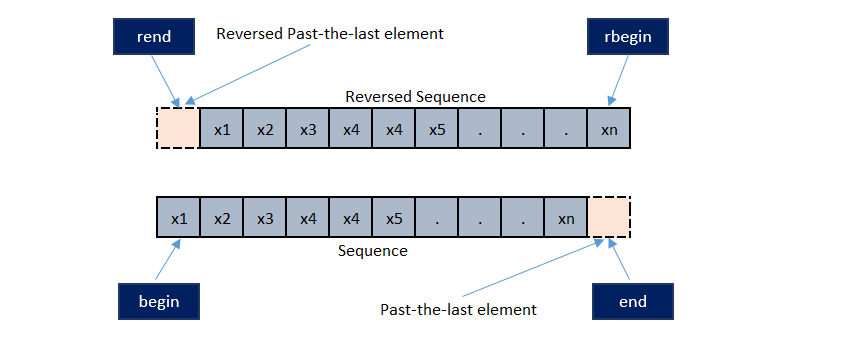C++ <vector> - rend() Function
The C++ vector::rend function returns the reverse iterator pointing to the element preceding the first element (reversed past-the-last element) of the vector. A reverse iterator iterates in backward direction and increasing it results into moving to the beginning of the vector container. Similarly, decreasing a reverse iterator results into moving to the end of the vector container.

Syntax
reverse_iterator rend(); const_reverse_iterator rend() const;
reverse_iterator rend() noexcept; const_reverse_iterator rend() const noexcept;
Parameters
No parameter is required.
Return Value
A reverse iterator to the reversed past-the-last element of the sequence container. If the sequence object is constant qualified, the function returns a const_reverse_iterator, else returns an reverse_iterator.
Time Complexity
Constant i.e, Θ(1).
Example:
In the example below, the vector::rend function returns the reverse iterator pointing to the element preceding the first element of the vector MyVector.
#include <iostream>
#include <vector>
using namespace std;
int main (){
vector<string> MyVector{"Alpha","Coding","Skills"};
vector<string>::reverse_iterator rit;
rit = MyVector.rend();
rit--;
cout<<*rit<<" ";
rit--;
cout<<*rit<<" ";
rit--;
cout<<*rit<<" ";
return 0;
}
The output of the above code will be:
Alpha Coding Skills
Example:
Lets see another example where the vector called MyVector contains integer values and vector::rend function is used with vector::rbegin function to specify a range including all elements of the vector container.
#include <iostream>
#include <vector>
using namespace std;
int main (){
vector<int> MyVector{10, 20, 30, 40, 50};
vector<int>::reverse_iterator rit;
for(rit = MyVector.rbegin(); rit != MyVector.rend(); ++rit)
cout<<*rit<<" ";
return 0;
}
The output of the above code will be:
50 40 30 20 10
❮ C++ <vector> Library


